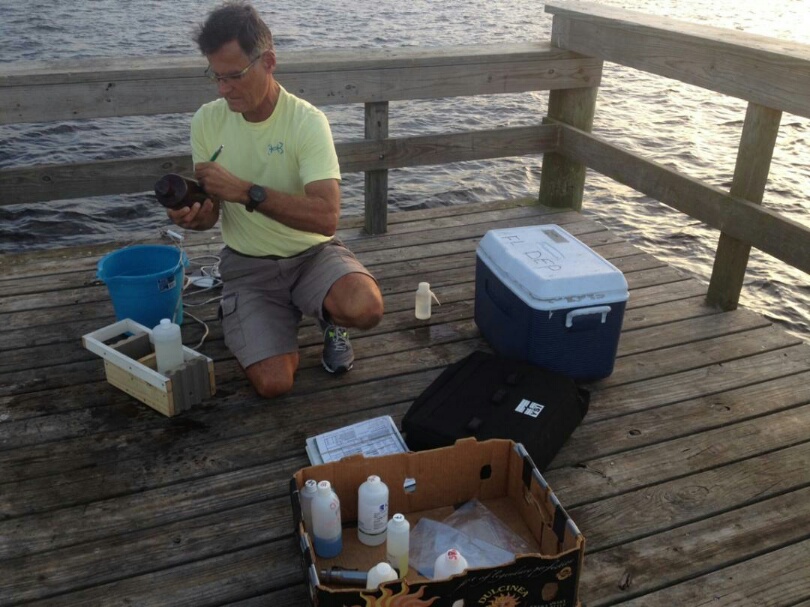The Charlotte Harbor Estuaries Volunteer Water Quality Monitoring Network is a coordinated system of more than 80 volunteers who regularly conduct water quality monitoring throughout the six local aquatic preserves in southwest Florida. The monitoring network ranges across Lemon Bay, Gasparilla Sound-Charlotte Harbor, Pine Island Sound, Matlacha Pass, San Carlos Bay and Estero Bay estuaries.
The project is a cooperative effort of the Florida Department of Environmental Protection, Charlotte Harbor & Estero Bay Aquatic Preserves Offices, the Charlotte Harbor Environmental Center, the Southwest Florida Water Management District's Surface Water Improvement Management Program and the Coastal & Heartland National Estuary Partnership.
The program is unique because it:
- Includes monitoring sites in all six of the aquatic preserves in the Charlotte Harbor estuaries
- Builds on and expands existing volunteer monitoring programs
- Provides both scientific and educational functions
- Includes critical quality assurance, data management and training components necessary for providing credible data and long-term volunteer support
Volunteers are the critical component to the success of the monitoring program. Educating volunteers and the general public about the values of estuaries through monitoring will lead to active, self-supporting citizens support organization for each of the aquatic preserves and the Charlotte Harbor National Estuary Program. The volunteer monitoring program was initiated in October 1996, and now more than 80 volunteers monitor 46 locations within the estuaries.
Once a month, volunteers sample 19 field parameters including:
- dissolved oxygen (DO)
- water temperature
- wind speed and direction
- pH
- air temperature
- precipitation
- salinity
- water clarity
- weather and water surface conditions
- water color
- water depth
- tide stage
In addition to the 19 parameters measured in the field, samples for six additional parameters are collected by volunteers and analyzed at the DEP Central Laboratory in Tallahassee. These parameters include:
- Enterococci or E. coli
- chlorophyll a
- turbidity
- color
- total nitrogen
- total phosphorus
Volunteers receive initial classroom training on the importance of estuarine environments and the need for their monitoring results. They learn how the estuaries change according to location and throughout the year. They also receive classroom training on the tested parameters and the techniques used.
After the initial classroom training, volunteers are trained in the field. To ensure high-quality data, all trained volunteers attend quality assurance practice sessions as a group twice a year.
Every month, volunteers record the data onto data sheets. The data is then entered into a database and transformed into graphs and tables. Graphs and tables give an understandable picture of the water quality of the sites over time. All of the data is uploaded into a federal database that is made available to scientists, state and local government agencies, policymakers and citizen organizations.
Data from this project has determined base level conditions throughout the estuary where little data previously existed. The data is available for uses in resource management, which includes activities such as permitting, recreational decisions, watershed land use and infrastructure decisions, determining permit compliance as well as determining future monitoring needs. In conjunction with other water and resource monitoring project designs, there is a better understanding of estuarine conditions in the local aquatic preserves.
Charlotte Harbor estuaries and tributaries are generally in good condition with higher levels of nutrients and color associated with summer rain and natural events. Lemon Bay tributaries have naturally lower dissolved oxygen and higher spikes in nutrients than the estuary itself. The data is used to set baseline estuary health conditions, long-term trend analyses and to identify specific areas needing further scientific study or management actions. The data has been used to help identify impaired waterbodies and set nutrient criteria standards. It also has been published in scientific journals, agency reports and is entered into the national STORET and WIN water quality databases. It is also available online for viewing or graphing at the Charlotte Harbor Water Atlas.
The Charlotte Harbor Estuaries Volunteer Water Quality Monitoring Network is always looking for volunteers. Contact Arielle Taylor-Manges at the DEP Charlotte Harbor Aquatic Preserves office in Punta Gorda at 941-389-5200 or Arielle.TaylorManges@FloridaDEP.gov.




